Blog - CHARGE GD II

Six new cross-border healthcare research projects will start at the Cross-border
Institute of Healthcare Systems and Prevention (CBI).
Next March 2022, six new cross-border healthcare research projects led by researchers from the Carl von Ossietsky University of Oldenburg (UOL) in Germany and the University of Groningen /Univerisity Medical Center Groningen (UMCG) in the Northern Dutch-German border region will start at the Cross-border Institute of Healthcare Systems and Prevention (CBI), as it has already been announced in a press release by the communication office from UOL. These cross-border health research projects are part of the "Comparison of healthcare structures, processes and outcomes in the Northern German and Dutch cross-border region (CHARE GD-II)" project, which receives 1.4 million euros in funding from the Volkswagen Foundation through the Lower Saxony Ministry of Science and Culture.
The German and Dutch health systems are among the best in the world. Nevertheless, they are faced by significant challenges in light of population ageing and the associated rising demand for healthcare. Our cross-border region serves as a perfect living lab in which lessons learnt on each side of the border can be leveraged for more healthy years in the Netherlands as well as Germany. Through the close collaboration between the University of Groningen and the University Medical Center Groningen on the Dutch side and the University of Oldenburg on the German side, the Cross-Border Institute for Healthcare Systems and Prevention serves as a one-stop-shop for interdisciplinary cross-border research. The CHARE GD-II project brings together research from medicine, economics, spatial sciences and health sciences from both sides of the border to lay the academic foundation for concrete challenges arising from the demographic transition. We are very happy that the CBI can serve as an intellectual pipeline for the region that enables us to leverage knowledge from the two regions as well as all the excellent work being done elsewhere in the world in support of more healthy years in our cross border region (Jochen Mierau, member of the CBI management board).
We interviewed researchers from the Dutch side, who participate in these cross-border research consortia to ask them what are their projects about? And what cross-border cooperation in health research means to them?
Subproject 1: Establishing a health and contextual data inventory to facilitate interdisciplinary cross-border research.
Researchers involved:
Dutch side: Dr. Tobias Vogt, Faculty of Spatial Sciences, UG; Prof. Dr. Viola Angelini, Faculty of Economic and Business, UG; Prof. Dr. Sandra Brouwer, University Medical Center Groningen.
German side: Prof. Dr. Sebastian Schnettler; Dr. Kai Willführ; Dr. Christian Lüpkes; Joachim Kieschke.
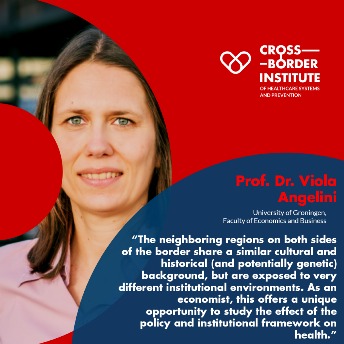
Cross-border health research relies heavily on comparable data sources to analyze differences and commonalities between both sides of the border. As part of our project, we will establish a health and contextual data inventory to facilitate interdisciplinary cross-border research. We also plan to use the data inventory for comparative research on determinants of life-course health by selecting and combining available secondary data sources.
The neighboring regions on both sides of the border share a similar cultural and historical (and potentially genetic) background, but are exposed to very different institutional environments. As an economist, this offers a unique opportunity to study the effect of the policy and institutional framework on health (Viola Angelini).
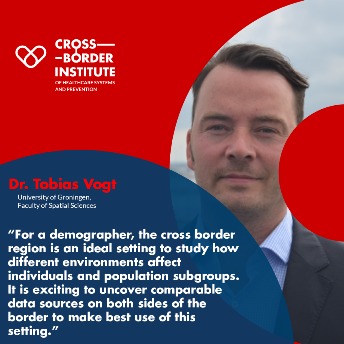
Health outcomes and demographic processes are largely shaped by our social and natural environment. For a demographer, the cross-border region is an ideal setting to study how different environments affect individuals and population subgroups. It is exciting to uncover comparable data sources on both sides of the border to make best use of this setting (Tobias Vogt).
Subproject 2: What do we do with the flu? Cross-border comparison of healthcare decision-making processes of general practitioners and patients regarding antibiotic prescription for upper respiratory infections.
Researchers involved:
Dutch side: Dr. Nienke Beerlage-de Jong, Twente University; Julia Keizer, Twente University; Dr. Esther Metting, UMCG; Dr. Adriana Tami, UMCG; Dr. Nadine Voelkner, Faculty of Arts; Prof. Dr. Lisette van Gemert-Pijnen, University of Twente; Dr. Maria F Vincenti-Gonzalez, UMCG.
German side: Prof. Dr. Lena Ansmann; Prof. Dr. Michael Freitag.
Primary patient care amplifies antibiotic resistance (ABR) through mis- and over-prescribing of antibiotics (ABX). This mis- and over-prescribing of ABX is referred to as Potentially Inappropriate Prescribing (PIP) and it has many potential adverse health effects. Especially in primary care, many factors contribute to PIP. For example, research has shown that physicians are more prone to prescribe (redundant) ABX if they feel pressured by their patients. Simultaneously, patients also actually feel more satisfied and are less likely to re-consult if they are prescribed ABX. And this even goes for viruses such as the flu, for which ABX are not indicated and will not work.
Studies have also shown that there are cross-border differences in ABX prescribing, although the reasons for these differences are not yet fully understood. This CHARGE GD II project is aiming to dive into this knowledge gap, and to learn from each other across the Dutch-German border. After all, individual behaviours are shaped by the individual’s beliefs and attitudes, but also by the context in which they operate (e.g. culture, politics, guidelines). This means that both physicians and their patients should be studied. But it also means that it is of added value to study the PIP phenomenon in a cross-border setting, since it offers a unique opportunity to study the impact of different cultural and health system contexts.
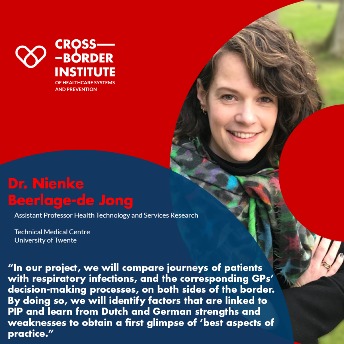
Therefore in our project, we will compare journeys of patients with respiratory infections, and the corresponding GPs’ decision-making processes, on both sides of the border. By doing so, we will identify factors that are linked to PIP and learn from Dutch and German strengths and weaknesses to obtain a first glimpse of ‘best aspects of practice’ (Nienke Beerlage-de Jong).
Cross-border collaboration brings an increased understanding in what factors shape health issues in our own region and country, since whatever happens across borders and especially to our region/country neighbours will invariably affect us. The COVID-19 pandemic has made it all too clear that we cannot behave as “islands” as we are all interconnected, and that health changes occurring in “faraway lands” will eventually reach us.
Health issues are influenced by political, economic, social and environmental factors. In order to tackle these in an efficient and strategic manner, cross-border collaboration is crucial. Populations in cross-border regions are very similar, but their contexts are quite different in the sense of culture and healthcare system, offering an unique opportunity for increased understanding. Here again, we have learned (or perhaps, are still learning) from the COVID-19 pandemic, where inter-sectoral, interregional, international and intercontinental collaboration is essential if we expect to control the pandemic.
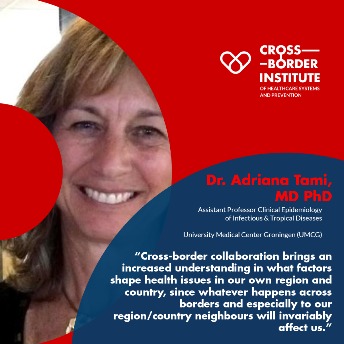
In our proposed research, “What do we do with the flu” the concepts above will be applied to attempt to harmonize cross-border healthcare given that both health care workers and patients increasingly work in or seek healthcare across our border region. In this manner we will also identify what could be an optimal (cross-border) strategy to deal with antimicrobial resistance bringing players from both sides of the border together (Adriana Tami).
Subproject 3: Early and Late Infections following Implant Surgery: DE-NL cross-border comparison
Researchers involved:
Dutch side: Prof. Dr. Paul Werker, UMCG; Dr. Ben Saleem, UMCG; Prof. Dr. Jean-Paul de Vries, UMCG; Prof. Dr. Banhu Sinha, UMCG; Prof. Dr. Lisette van Gemert-Pijnen, University of Twente; Dr. Marleen van Oosten, UMCG; Dr. Irene Krabbe-Timmerman, UMCG; Prof. Dr. Clark Zeebregts, UMCG; Dr. Ilona Hospers, OZG; Dr. Marjan Wouthuyzen-Bakker, UMCG
German side: Prof. Dr. Rudy Leon De Wilde; Prof. Dr. Oliver Dewald; Dr. Martin Tenger; Prof. Dr. Axel Hamprecht; Dr. Luz Angela Torres-de la Roche
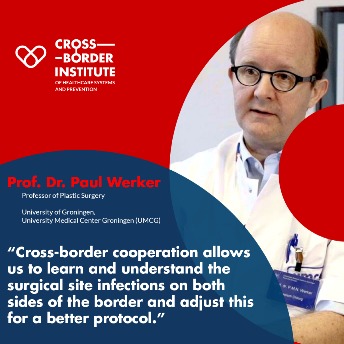
Surgical site infections following breast prosthesis and vascular prosthesis implants is a devastating complication. We want to disclose the differences on both sides of the border and to get insight into ways prostheses patients are treated around their operations in order to try and learn from each other.
Cross-border cooperation allow us to learn and understand the surgical site infections on both sides of the border and adjust this for a better protocol (Paul Werker).
Subproject 4: Multidrug-resistant bacteria (MDR) - analysis of differences in infection prevention and control measures, diagnostic workup and MDR prevalence in the Northern Dutch-German border region
Researchers involved:
Dutch side: Prof. Dr. Bhanu Sinha, UMCG; Dr. Corinna Glasner, UMCG; Prof. Dr. Alexander W. Friedrich, UMCG; Dr. Nienke Beerlage-de Jong, University of Twente; Prof. Dr. Lisette van Gemert-Pijnen, University of Twente; Prof. Dr. Maarten Postma, UMCG; Dr. Adriana Tami, UMCG; Dr. Janine de Zeeuw, UMCG; Dr. Erik Bathoorn, UMCG; Dr. Mariette Lokate, UMCG; Dr. Berry Overbeek, UMCG
German side: Prof. Dr. Axel Hamprecht; Dr. Hans-Jürgen Wietoska
This project aims at analysing the differences in infection prevention and control (IPC) measures, diagnostic workup and multidrug-resistant bacteria (MDR) prevalence in the Ems-Dollart region for a better insight for tackling antimicrobial resistance (AMR) in a European cross-border region. By providing a basic framework for these similarities and differences a foundation for an integrated cross-border healthcare in the field of medical microbiology and IPC system will be laid, which can help to improve patient care in a European border region.
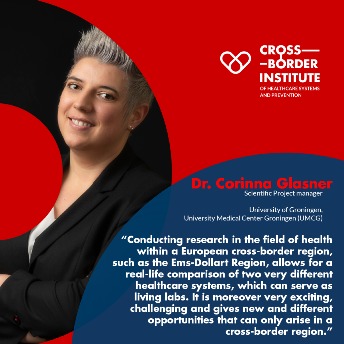
“Conducting research in the field of health within a European cross-border region, such as the Ems-Dollart Region, allows for a real-life comparison of two very different healthcare systems, which can serve as living labs. It is moreover very exciting, challenging and gives new and different opportunities that can only arise in a cross-border region“ (Corinna Glasner).
Subproject 5: The use of closed doors in dementia wards. Comparing cultural and moral perspectives as well as contexts for mutual learning in the cross-border region
Researchers involved:
Dutch side: Prof. Dr. Sytse Zuidema, UMCG; Dr. Elleke Landeweer, UMCG; Dr. Sarah Janus, UMCG; Dr. Brenda Frederiks, Amsterdam UMC
German side: Prof. Dr. Mark Schweda; Prof. Dr. Michael Freitag; Prof. Dr. Tania Zieschang
When is a closed-door policy of care units specialized in advanced dementia acceptable? People with severe dementia living in nursing homes may need protection to prevent wandering outside without supervision. But does a closed door protect residents in a good way? What less restrictive alternatives can be used and are actually used in practice?
In this research project, we will explore if and when a closed door is acceptable for residents with advanced dementia, how this is dealt with in practice and if/how the practice can be improved. To this end, we will conduct comparative research in the regions of North Netherlands and North-West Germany (Niedersachsen), investigating for which residents the research topics apply, what interventions are already in place and what differences and similarities (cultural, moral and legal) exist.
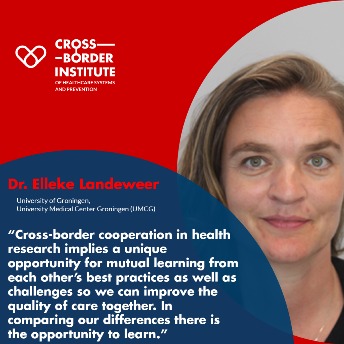
Cross-border cooperation in health research implies a unique opportunity for mutual learning from each other’s’ best practices as well as challenges so we can improve the quality of care together. In comparing our differences there is the opportunity to learn (Elleke Landeweer).
Subproject 6: Tomorrow’s vital workforce in the cross-border region: how to deal with the shortage of nurses in hospitals?
Researchers involved:
Dutch side: Prof. Dr. Sandra Brouwer, UMCG; Prof. Dr. Evelyn Finnema, UMCG; Prof. Dr. Klaske Veth, Hanze University
German side: Prof. Dr. Lena Ansmann; Prof. Dr. Andreas Hein; PD Dr. Anna Levke Brütt; Dr. Adriana Perez-Fortis
Our project aims to (1) systematically compare the personnel situation in hospitals in the Ems-Dollart region, (2) identify similarities, differences and best-practices in recruitment and retention strategies of nurses in this cross-border region, and (3) identify and quantify needs, preferences and levels of acceptance of nurses and hospital management in regard to technological solutions in times of nursing shortage. The data collected will give insights into hospitals’ human resources strategies in the cross-border region as well as nurses’ needs and readiness for technology for improving the work environment. This information may support hospital management in addressing the nurse shortage in the Ems-Dollart region as an essential part of the vital workforce and healthcare.
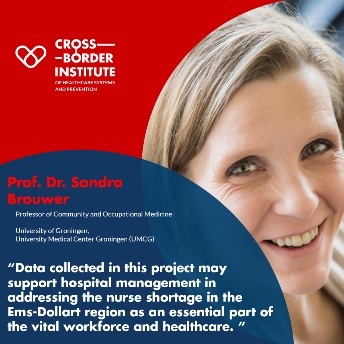
Working together on the continuity of the Dutch-German healthcare of tomorrow: innovative approaches to effectively address the complex issues underlying today’s shortage of nurses (Sandra Brouwer).
In these cross-border healthcare research consortia, researchers from different faculties (e.g. Faculty of Economic and Business, Faculty of Spatial Sciences, Faculty of Medical Sciences from the UG, School of Medicine and Health Sciences and School of Education and Social Sciences at UOL,) and institutions (e.g. Hanze University of Applied Sciences, University of Twente, Ommelander Ziekenhuis Groningen, Klinikum Oldenburg, Pius Hospital Oldenburg, Klinikum Leer, University Medical Center Groningen, OFFIS, among others) in our region participate, showing the transdisciplinary approach of the projects.
Today more than ever cross-border cooperation in health is mainly needed in border regions. An empirical report by the Mission Opérationnelle Transfrontalière (MOT) and the European Union (2021), on the effects of COVID-19 on cross-border regions, showed that all regions suffered, but citizens living in cross-border regions suffered double penalty. Therefore, it is important to consider cross-border communities as living areas rather than lines, strengthening a bottom-up cross-border multilevel governance approach between cross-border regions, Member States and the European Union. The European cross-border regions are the best placed to test new ideas and implement innovative health solutions, with these six cross-border healthcare research projects, the CBI aims to contribute to this goal. The ever closer union of Europeans happens in cross-border regions, Groningen and Oldenburg know it! (Adriana Pérez-Fortis, scientific coordinator CBI).



